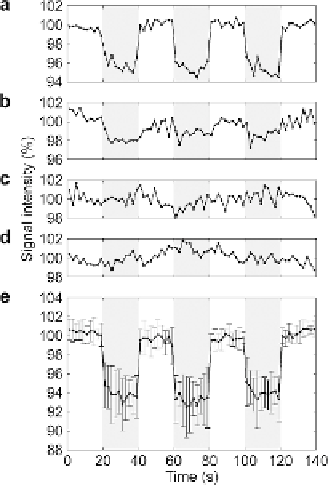Biomedical Engineering Reference
In-Depth Information
Fig. 14.8. Time courses during alternating periods of rest and electrical stimulation.
These results were obtained using: (
a
) Three cycles of gradient oscillations and three
electrical pulses synchronized with the negative gradient lobes (Exp. 1); (
b
) the same
as (
a
) but with two cycles of gradient oscillations and two electrical pulses (Exp. 2); (
c
)
the same as (
a
) but with the electrical pulses delayed by 50 ms (Exp. 3); (
d
) the same
as (
a
) but without oscillating gradients (Exp. 4); (
e
) the same as (
a
) but averaged over
seven different experimental sessions. The time courses in (
a-d
) were averaged over the
activated region obtained in Experiment 1; the time course in (
e
) was averaged over the
activated regions of all seven sessions. The error bars represent the standard deviation
over the seven sessions. Each time course is normalized to the mean signal intensity
during rest. The rest and stimulation periods are shown in white and gray, respectively.
Less significant activation was detected in Experiment 2, in
which only two cycles of gradient oscillations and two synchro-
nized electrical pulses were used. The time course averaged over
the same activated region as in Experiment 1 shows a signal
decrease of only (1. 5
0. 6)% during the stimulation periods
(
Fig. 14.8b
). This finding illustrates that the sensitivity of our
technique can be significantly decreased when there is insuffi-
cient loss of phase coherence, which is consistent with its contrast
mechanism.
As expected, no activation was detected in either control
experiment, in which the electrical pulses were delayed with
respect to the oscillating gradients (Exp. 3) or in which no
oscillating gradients were used (Exp. 4). The time courses aver-
aged over the same activated region as in Experiment 1 show
no systematic signal changes during the stimulation periods
(
Figs. 14.8c and d)
. These results further validate the contrast
mechanism of our technique by demonstrating that the observed
activation is indeed due to the loss of phase coherence generated
±

